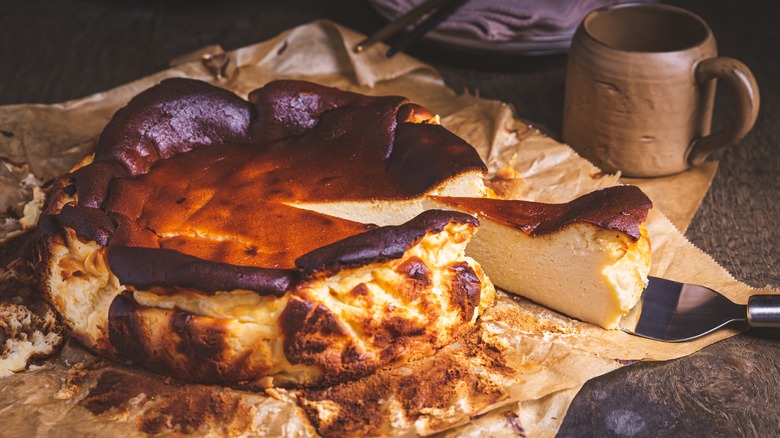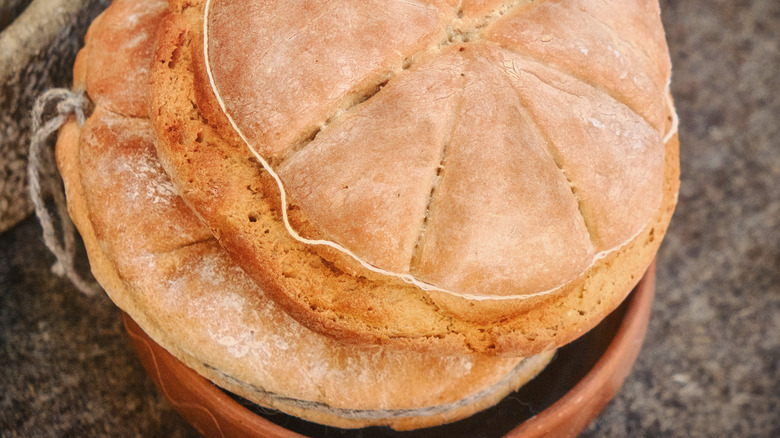Is Cheesecake Pie, Cake, Both, Or Its Own Thing?
Should cheesecake have an existential crisis? With "cake" in its name and a crumbly crust akin to pie at the bottom, this decadent dish straddles two very different dessert categories. One may even argue that its many forms — from burnt basque to Japanese to the iconic New York style — justify giving cheesecake its own category.
Part of the conundrum stems from the fact that both the ingredients and the assembly of most cheesecakes defy categorization as either cake or pie. There is neither flour involved nor is there any filling. However, look into cheesecake's rich history, and you'll find a surprising origin story going back thousands of years to ancient Greece. As it turns out, cheesecake has worn both cake and pie hats over the years. So is cheesecake a pie, a cake, a hybrid of both, or something else entirely? To get to the creamy heart of the question, let's take a look at just how much the definition of a cheesecake can actually stretch and which kind of dessert it shares the most similarities with.
Assembled like a pie and baked like a cake
When it comes to assembling this cheese and graham cracker-crusted delight, traditional cheesecakes veer toward pie territory. In its most common form, the base of a cheesecake consists of crushed graham crackers, which can be substituted with chocolate biscuits like Oreos or even crumbled ginger snap cookies. It all depends on the flavors to be piled on top.
Next comes the decadent cheese topping — a combination of cheese, eggs, and sugar thickly layered over the crust. At this point, the cheesy "batter" may resemble that of a cake. Subsequently, slow baking and chilling firm it up so it can be cut into perfect slices. Despite some similarities in the baking process, generally, no flour is added to the cheese mixture. Therefore, it has a creamy texture that's very different from the bread-like texture of most cakes. Hence, cheesecake seems closer to a pie or even an oversized tart in texture and structure, especially one with a cheese or custard filling.
However, bring a crustless cheesecake like the burnt basque or the cottony soft Japanese version into the mix, and all similarities with the pie go out the window. These cheesecakes are made without the signature crust, and their cheese batter also contains traces of flour, bringing them clearly into cake territory. So, depending on the type of cheesecake being made, the preparation may resemble cake or pie, but the final dish result tends to elude both categories.
A cheesecake can be many things
Given the variation its recipe can encompass, the definition of a cheesecake is quite malleable. You can find several different plain, fruit, chocolate, and flavored cheesecakes at most bakeries, but to truly get an idea of how cosmopolitan this cheese dish is, it's worth looking at cheesecake counterparts from around the world.
Any version of a cheesecake generally centers around the creaminess of the cheese complimented by tangy and sweet flavors. Most also include an element of crunchy or crumbly texture to contrast the gooey cheesiness. This combination results in delicious treats in several countries, from Polish Sernik embellished with candied fruit to the local favorite Fiadone from Corsica, which contains a splash of local fruit brandy. Turkish Peynirli künefe is filled with local clotted cream and topped with crushed pistachios, while Russian Vatrushka is made with fresh milk curds and raisins. The latter is lightly sweetened and is generally eaten for breakfast or as a snack — a stark contrast to cheesecake's dessert persona. Of course, one may argue that any time is a good time for cheesecake.
Ultimately, just as both cake and pie have spanned the world and spawned innumerable adaptations, so has cheesecake. It is a dish that has several sub-genres of its own and could even pre-date many of the dishes we eat today, including the ones it is being compared to here.
From ancient Greece to New York cafes
Cheesecake's story began in ancient Greece as a (let's call it cake) made of honey, cheese, and flour called "Plakous" that was fed to athletes of the first Olympic Games circa 776 B.C. The dish then spread more widely after the dominion of the burgeoning Roman Empire, undergoing several tweaks along the way. In fact, in one of the oldest surviving records in Latin, "De Agri Cultura," by Roman senator Cato, the author's description of his favorite cake (savillium) comes close to modern-day cheesecake. The recipes for savillum and similar dishes of the time generally involved mixing and baking various local kinds of cheese with flavoring ingredients and flour; the ancient cheesecake was more of a cake than a pie.
Fast forward to the early 20th century — Arnold Reuben, owner of the iconic Turf Restaurant in New York City and inventor of the eponymous sandwich, is also credited with creating the New York-style cheesecake. Urban legend states that a cheese dish at a dinner party is what inspired him. To tangle things further, that dish happened to be a cheese pie! So, was the iconic New York cheesecake inspired by a pie? It would be fun to believe so. Ultimately, with a history as rich and colorful as this, to say nothing of the legions of eaters it has satiated for millennia, cheesecake deserves to be in a category of its own. There's nothing else quite like it.



